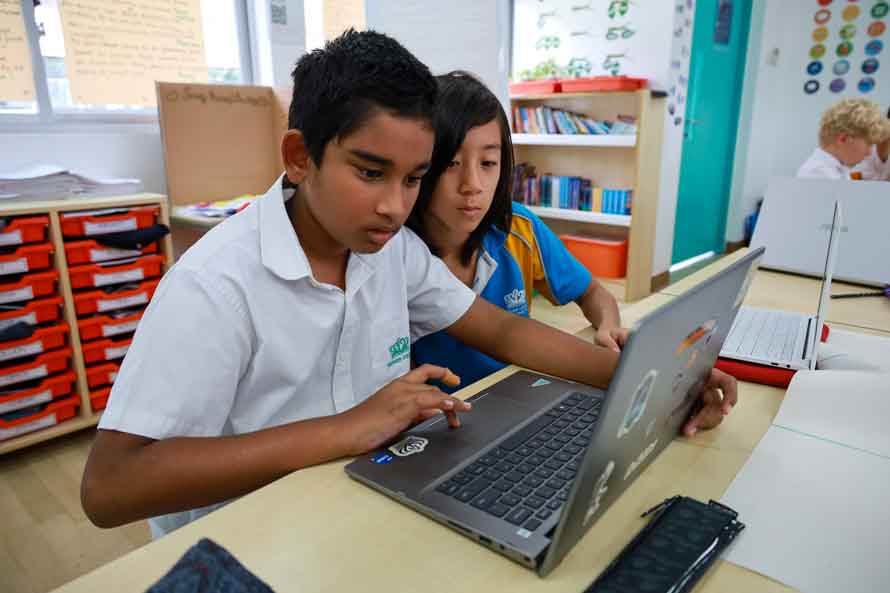Join Dover Court this January!
Limited places still available in select year groups - Enquire Today

Edtech has transformed education and changed the learning needs of our children, empowering them at every stage of their journey. At Dover Court International School, we operate on a BYOD (Bring Your Own Device) policy for students in Primary School to ensure technology is seamlessly embedded into the learning experience in all curriculum areas.
With the right devices, we can prepare students with the skills and relevant learning experiences to inspire creativity, help students apply meaning to their learning and prepare them for the future. Dan Franklin, our Whole School Deputy Head of Educational Technology shares more about education technology and our Primary BYOD programme.
The Bring Your Own Device (BYOD) programme has been a part of the student experience in Years 5 and 6 since the 2019-2020 academic year. Why BYOD?
We believe that a BYOD programme provides an opportunity for a well-rounded approach to three core areas of focus:
BYOD is a natural progression from the use of devices in the previous year groups in the primary school. It allows us to progressively develop students' use of technology, by moving from an immersive to a more integrated digital experience.
"I know it is a massive cliché, but the BYOD programme has been a real game-changer in Year 5," says Mr Cairns, a Year 5 teacher.
He continues, “it has encouraged the development of crucial skills such as independence, responsibility, organisation and collaboration.”
A key part of the BYOD programme is the development of the sense of ownership and the responsibilities that this may bring.
Firstly, taking care of the device is an important factor of the programme - ensuring the device is ready for learning; safely transporting it to and from school; using it safely and responsibly whilst around school; and starting to distinguish between how to use devices for learning versus for pleasure.
Secondly, we can develop students’ understanding of technology-related wellbeing, modelling examples of when devices should or should not be used, how they can enhance a task, the importance of being aware of screen time but more so the quality of the time spent in front of a screen. So, how are the devices used?
During virtual learning, as a result of the pandemic, the model of technology in learning that would have been seen at home was very static with the device as the vestibule for all learning. This is what was needed for that situation but is not the model of effective technology use in school.
Using technology across the primary school we promote balance, variety of use, opportunities to collaborate and share with families through Seesaw. As Mr. Cairns says, “it is used, as any tool is, when it can serve to compliment what is happening in class.” (this hopefully answers one of the most asked questions by parents!)
Across just Years 5 and 6 this year, examples of use include students viewing rockets blasting off through augmented reality; taking virtual field trips around the world (and even to the moon); adapting and creating pieces of art; and creating educational videos in maths. When talking to some students, they said that using their devices allows for a “different way of learning,” and remarked that one of the benefits of the BYOD programme is being able to continue “working on projects and extending learning at home.” In addition, they shared that they enjoyed “taking my device home to show my parents my progress,” and, “posting on Seesaw for parents to see.”
Mrs. Richardson, Year 6 teacher, explains that having the children with access to a device, “supports students to have much more independence and inquiry within their work.”
"Whether it's using Minecraft to create a habitat for an animal, Canva to create a colourful, moving presentation or Tinkercad to design renewable energy sources for an isolated island, the children are more engaged in activities which allow them to learn, often without realising that they are learning," says Mrs. Richardson, a Year 6 teacher.
What’s next? As we continue to evolve our approaches to using technology across the curriculum, the experience of the learner is our number one focus. For the next academic year, we are looking forward to expanding the programme to include our Year 4 students, by providing them with the same enhanced experience our Years 5 and 6 have been enjoying. We would also like to continue to develop the sense of ‘your own’ part of the BYOD programme.
There are many built-in features in devices that can allow all learners the ability to unlock increased focus, productivity and effective use of their device. In fact, one of the students I spoke to remarked, “using my own device allows for a personalised use” and this is exactly what we would like to further develop.
Daniel Franklin
Whole School Deputy Head, Educational Technology